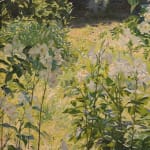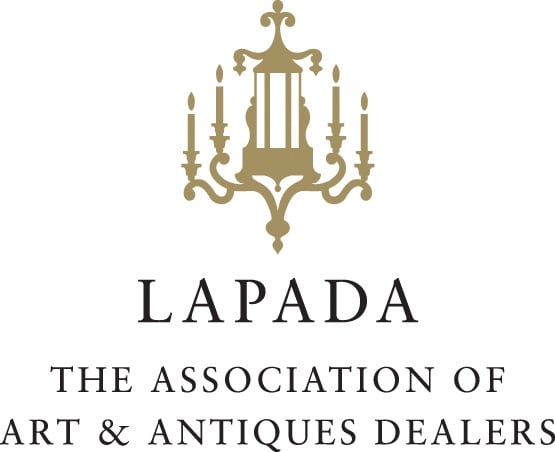William Leech 1881-1968
Framed: 128 x 104 cm.; 50 x 41 in.
The Secret Garden is one of the finest paintings by Leech remaining in private hands, which relates to his most famous work The Convent Garden (1912, National Gallery of Ireland). The subject is a luscious, sun-filled garden where lilies, grass and leaves dance amongst one another in a symphony of lively brushwork and colour, which reveals Leech’s accomplished artistic skill. He does not use a conventional horizon or perspective in his composition; rather he focuses his attention on the lilies in the foreground, while the clever use of light and shadow and fluid brushstrokes leads the eye through the lilies, beyond the dappled tree leaves above, to an enclosed hedgerow behind.
Born in Dublin, Leech had trained under influential Irish painter, Walter Osborne, at the Royal Hibernian Academy. It is likely Leech knew of Osborne’s A Cottage Garden that also takes lilies as its subject, but in the freedom and vibrancy of The Secret Garden, Leech pushes boundaries further. In 1903, he had gone to Paris to study, from where he travelled to Concarneau, one of several artistic colonies in Brittany. There he befriended John Lavery, who had already well-established himself in France.
Leech spent several years in Concarneau. The present work developed while Leech was convalescing at the Sisters of the Holy Ghost after contracting typhoid fever in 1904. The grounds of the convent hospital very much represented a ‘secret garden’ and one to which Leech had privileged access. The title also links to Frances Hodgson Burnett’s novel, The Secret Garden, written in America in 1909, which tells the story of a young girl also recovering from typhoid, who finds respite in a secret, walled garden of her own. Drawings and sketches of Leech’s time there led to the present painting, executed circa 1911, and A Convent Garden, Brittany, which expands upon The Secret Garden by including the Sisters. Most immediately, the paintings recall John Singer Sargent’s famous Carnation, Lily, Lily, Rose (Tate, London). The Secret Garden however, like its namesake, retains an air of mystery and informality.
Leech’s time in Brittany was a critical period for him, with Denise Ferran commenting how The Secret Garden, ‘shows a freedom and facility to render colour and light, which strengthened in Leech’s work from 1910 onwards, after several years of painterly development in Concarneau.’ (Ferran, William John Leech: An Irish Painter Abroad, London, 1993, p.166). In recognition of his stature, Leech was elected a full member of the Royal Hibernian Academy in 1910 aged only twenty-eight. The Secret Garden and its counterpart, A Convent Garden, Brittany, represent Leech at the height of his artistic achievements.
Provenance
The Artist, thence by direct family descentPrivate collection since 2004
Exhibitions
Dublin, Royal Hibernian Academy, 1920, no.147 (£75);London, Royal Academy, Summer Exhibition, 1921, no.123 (as Lilies, one of only nine paintings ever exhibited by Leech at the London Academy);
Dublin, National Gallery of Ireland, William John Leech, An Irish Painter Abroad, 1996, no.36.
Literature
Denise Ferran, 'W.J. Leech's Brittany', Irish Arts Review, 1993, pp.228-9, illustrated;Denise Ferran, William John Leech: An Irish Painter Abroad, National Gallery of Ireland in Association with Merrell Holberton, London, no.36, illustrated in colour, p.165;
Anne Crookshank and the Knight of Glin, Ireland's Painters, 1600-1940, published for the Paul Mellon Centre for Studies in British Art, Yale University Press, New Haven and London, 2002, p.292.




